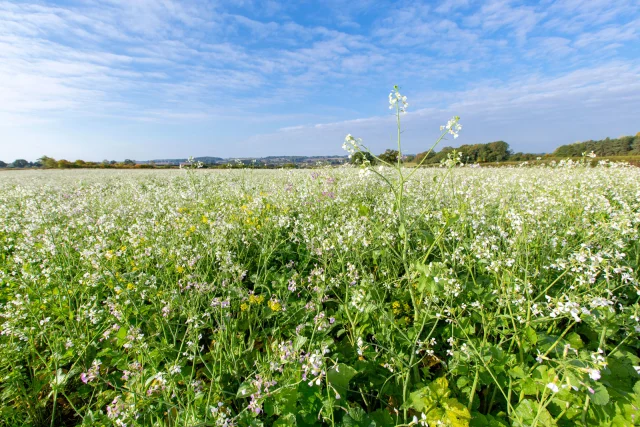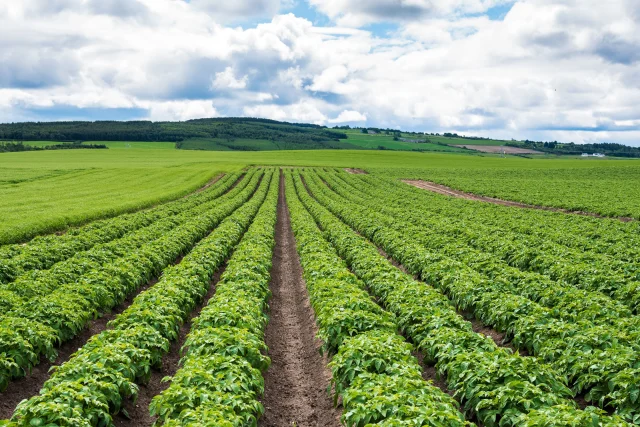Published on 1st February 2020
Pest Management
Managing PCN: 6 key actions for success

Expertise advice on managing PCN through 6 key actions for success.
Managing PCN: 6 key actions for success Content
1. Determining species and population
The first step to effectively managing potato-cyst nematodes (PCN) (and to a large extent, free-living nematodes) is to sample soils to identify the species present and the population density. This is best done after the potato crop is harvested as PCN will be most easily detected and therefore test results will be most accurate.
Testing pre-planting is also a useful management tool though it should be done in good time before planting begins to allow management interventions, such as rotation, trap cropping and chemical control, to be evaluated.
2. Understanding PCN distribution
Spatial distribution of PCN across any field is not uniform, neither is it random. Following an initial infestation at one or more points (focus/foci) in the field, the infestation spreads in a patchy manner, giving rise to secondary foci, which spread similarly. These foci may appear to be isolated, but by the time the infestation is readily detectable the whole field is likely to be infested, although it may still be below the limit of detection in some parts.
Vertical distribution of PCN within the soil profile can vary considerably, depending on the time elapsed since the last potato harvest and subsequent cultivations. However, if detection is the prime objective, the depth to which samples are taken within the top 20cm of field soils will have little or no effect on the result.
3. Understanding the sampling results
When it comes to PCN management, a ‘PCN not detected’ result should not be taken to mean any more than that and a management plan to prevent PCN escalation should still be put in place. Populations at the limit of detection – 5 million cysts/ha – have probably taken five or more crop rotations from the original introduction to get there. All fields on farms with any PCN infected land should therefore be considered likely to be infested and in need of a PCN management plan.
With the general increase in Globodera pallida PCN populations a concerted effort to reduce populations is critical wherever PCN is detected or likely to be present. Thresholds are now redundant for the purpose of managing PCN populations and should only be used to support decisions for managing crop.
4. Thresholds for Action
Source: Scottish Agronomy
5. Using rotation and varieties to manage populations
Understanding which species – Globodera pallida or Globodera rostochiensis or both – are present is the first step in developing an integrated pest management strategy as this will inform variety choice and rotation length.
Varieties differ in their resistance and tolerance to the two species while the rotation length needed is often influenced by the variety to be planted, its resistance rating, and the reproduction rate of PCN (with or without nematicide).
Varietal resistance and tolerance to G. pallida and G. rostochiensis
Reference: AHDB. Bold type denotes IVY testing. * denotes breeders testing.
Rotation periods needed to prevent a PCN population increase (without a nematicide)
Source: AHDB PCN Calculator. Assumes a 20% annual decline on light silt soils.
Using the above calculator, planting the UK’s most popular variety Maris Piper or the second most popular variety, Markies, both of which have a low resistance to G. pallida, into soil where PCN is dominated by the same species without the protection afforded by a nematicide, would require a rotation length of 13-15 years.
Rotation periods needed to prevent a PCN population increase with the use of nematicide
Source: AHDB PCN calculator. Assumes a 20% annual decline on light soils.
Using a nematicide to good effect can cut the rotation length needed for Maris Piper or Markies by about four years to between nine and 11 years. Using a resistant variety, such as the specialist type, Eurostar, which has a high resistance to both G. pallida and G. rostochiensis, can further reduce the length of rotation needed to avoid a population increase.
It should be noted that growing a susceptible variety (score of 2 or 3), even with a nematicide, a rotation of one-in-nine will probably be required to prevent populations increasing over time.
6. Using nematicides to manage populations
Nematicides should be used wherever a field is found to be infected with PCN (equally, where a field is known to be infected with FLN) and, where possible, a resistant variety planted.
In lower-pressure situations (less than 5 eggs/gram of soil) a single application of Velum Prime (fluopyram) has been found to be economically viable. Across seven seasons, the average yield response in such situations is 2.1t/ha and an average reduction in PCN egg counts of 41% compared with the untreated control.
In higher-pressure situations it can make sense to apply Velum Prime in combination with a granular nematicide such as Vydate 10G (oxamyl) or Nemathorin 10G (fosthiazate).
Applying Velum Prime in sequence with half-rate Nemathorin 10G delivered an additional 1t/ha in yield and with half-rate Vydate 10G gave an additional 2.7t/ha over the granular nematicide applied at the full rate.
Velum Prime gives extra yield protection in sequence with granular nematicide

Source: Bayer, UK trials 2016-19




